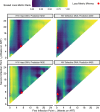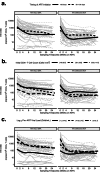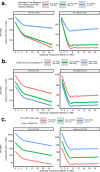Rapid biphasic decay of intact and defective HIV DNA reservoir during acute treated HIV disease
- PMID: 39557853
- PMCID: PMC11574060
- DOI: 10.1038/s41467-024-54116-1
Rapid biphasic decay of intact and defective HIV DNA reservoir during acute treated HIV disease
Abstract
Despite antiretroviral therapy (ART), HIV persists in latently-infected cells (the HIV reservoir) which decay slowly over time. Here, leveraging >500 longitudinal samples from 67 people living with HIV (PLWH) treated during acute infection, we developed a mathematical model to predict reservoir decay from peripheral CD4 + T cells. Nonlinear generalized additive models demonstrated rapid biphasic decay of intact DNA (week 0-5: t1/2 ~ 2.83 weeks; week 5-24: t1/2 ~ 15.4 weeks) that extended out to 1 year. These estimates were ~5-fold faster than prior decay estimates among chronic treated PLWH. Defective DNA had a similar biphasic pattern, but data were more variable. Predicted intact and defective decay rates were faster for PLWH with earlier timing of ART initiation, higher initial CD4 + T cell count, and lower pre-ART viral load. In this study, we advanced our limited understanding of HIV reservoir decay at the time of ART initiation, informing future curative strategies targeting this critical time.
© 2024. The Author(s).
Conflict of interest statement
Figures






Update of
-
Rapid Biphasic Decay of Intact and Defective HIV DNA Reservoir During Acute Treated HIV Disease.medRxiv [Preprint]. 2024 Aug 22:2024.03.27.24304867. doi: 10.1101/2024.03.27.24304867. medRxiv. 2024. Update in: Nat Commun. 2024 Nov 18;15(1):9966. doi: 10.1038/s41467-024-54116-1. PMID: 38585951 Free PMC article. Updated. Preprint.
References
-
- Hocqueloux, L. et al. Long-term immunovirologic control following antiretroviral therapy interruption in patients treated at the time of primary HIV-1 infection. AIDS24, 1598–1601 (2010). - PubMed
-
- Perelson, A. S. et al. Decay characteristics of HIV-1-infected compartments during combination therapy. Nature387, 188–191 (1997). - PubMed
Publication types
MeSH terms
Substances
Associated data
Grants and funding
- R01A141003/U.S. Department of Health & Human Services | NIH | National Institute of Allergy and Infectious Diseases (NIAID)
- U24 AI143502/AI/NIAID NIH HHS/United States
- A126326/ViiV Healthcare
- K23 GM112526/GM/NIGMS NIH HHS/United States
- UM1 AI164560/AI/NIAID NIH HHS/United States
- UM1AI164560/Delaney AIDS Research Enterprise (DARE)
- K23GM112526/U.S. Department of Health & Human Services | NIH | Center for Information Technology (Center for Information Technology, National Institutes of Health)
- IN-US-236-1354/Gilead Sciences (Gilead)
- 108072-50-RGRL/amfAR, The Foundation for AIDS Research (amfAR)
LinkOut - more resources
Full Text Sources
Medical
Research Materials

